Eighteen months ago, Iraqi forces backed by heavy coalition firepower descended on Mosul, Iraq’s second city and the largest ever controlled by the Islamic State. It took them nine months—well beyond initial estimates—to dislodge the terror group. During that time, strategies changed. Under the Obama administration, more commanders with the U.S.-led coalition were given latitude to call in strikes. When Donald Trump took office, he grew that trend, and embraced so-called “annihilation” tactics. In parallel, Iraqi security forces suffered heavy casualties early in the fight among their elite units, and later operated with fewer restraints. By the time the city was captured in July of last year, it was littered with some eight million tons of rubble—three times the mass of the Great Pyramid of Giza, the UN noted.
The urban fighting in Mosul that began on October 16, 2016 was described by U.S. officials as the most intense since World War II. Backing Iraqi forces on the ground, the U.S.-led coalition, which included a dozen partner countries, carried out more than 1,250 strikes in the city, hitting thousands of targets with over 29,000 munitions, according to official figures provided to us. But in the nine months since the reclamation of Mosul, those involved in the operation have conspicuously neglected to assess how many civilians were killed. There remains no official count of the dead in Mosul.
In December 2017, the Associated Press estimated that 9,000 to 11,000 civilians had died in the battle—an estimate nearly 10 times higher than what had been officially reported. At least a third of those deaths, the AP found, came as a result of coalition or Iraqi bombardments. In a separate investigation, NPR reported that the city morgue had recorded the names of 4,865 individuals on death certificates, dating between October 2016 and July 2017, and estimated that more than 5,000 civilians had been killed.
While these reports filled what had, in effect, been a vacuum, they were met with little concern from Western authorities. Neither Washington nor its local and international allies have shown any indication that they will undertake a comprehensive survey of the loss of life in Mosul. Nor have they taken significant steps to compensate the families of those their forces killed inadvertently. While the Pentagon does make such payments and did so during the Iraq war, it has only done so twice in the war against ISIS.
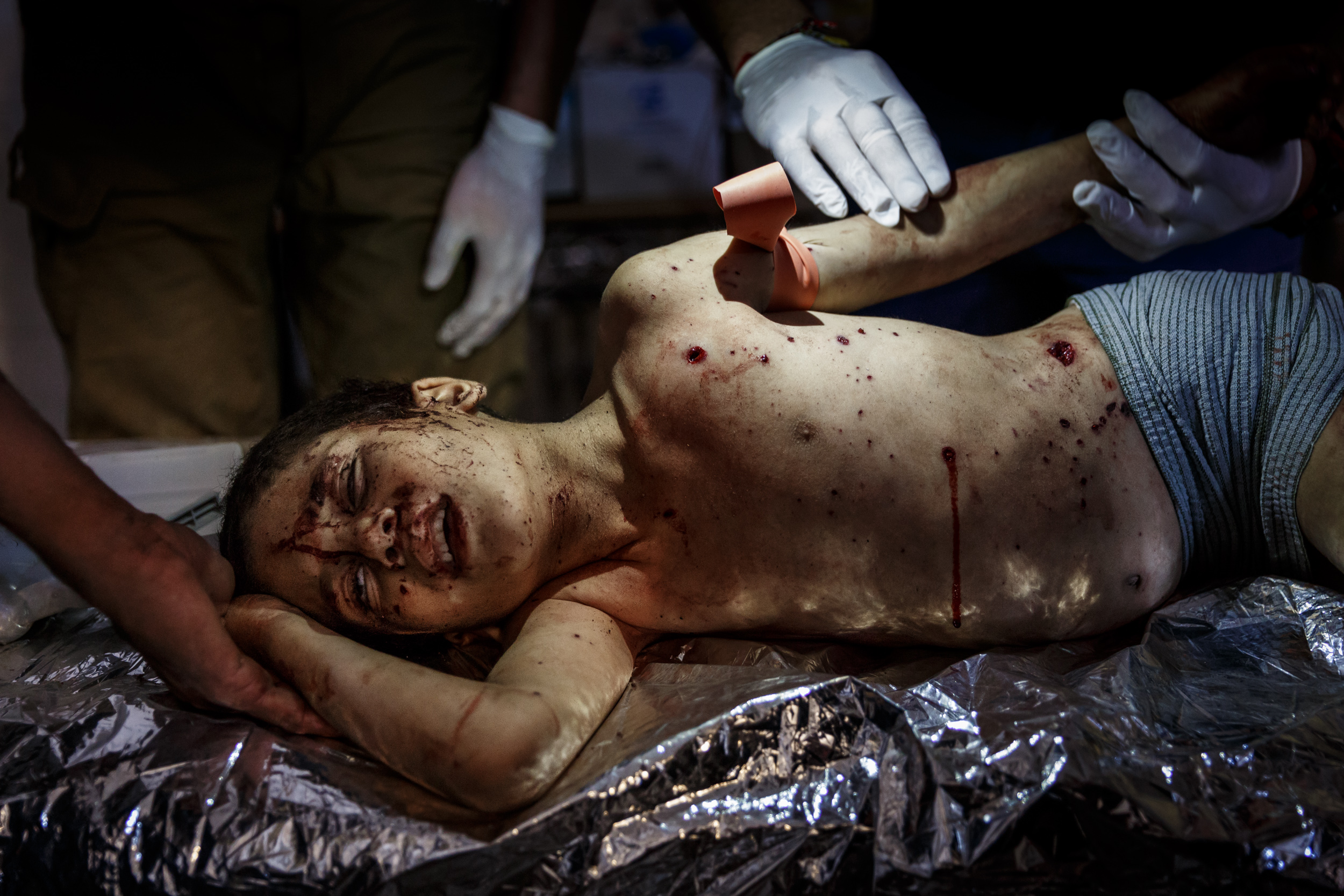
Medics work to stabilize Ammar, age 8. The young Moslawi boy was brought to “Trauma Stabilization Point #2” following an airstrike on the night of June 12, 2017 in West Mosul, Iraq. (Maranie R. Staab)
“It is simply irresponsible to focus criticism on inadvertent casualties caused by the coalition’s war to defeat ISIS,” spokesperson Colonel Thomas Veale told the AP in response to its report. “Without the coalition’s air and ground campaign against ISIS, there would have inevitably been additional years, if not decades of suffering and needless death and mutilation in Syria and Iraq at the hands of terrorists who lack any ethical or moral standards.” This argument—that acting decisively and with overwhelming force in an urban battlefield saved lives in the long term—is belied by an official lack of interest in finding how many died overall, no matter the culprit.
The question of who, if anyone, is accurately tracking civilian deaths is difficult to answer. Both the Pentagon and U.S. embassy in Baghdad directed questions about civilian deaths to the counter-ISIS coalition, the body that represents the countries supporting government forces in Iraq’s fight against ISIS. However, the coalition has only investigated strikes it has identified as its own and found reason to review. This means that only U.S. and French artillery strikes in Mosul, and U.S., British, French, and Australian airstrikes on the city are subject to review—a process which thus far has yielded civilian death estimates far lower than our own, which are based on local reports and the coalition’s own strike data. But the coalition’s tally represents only a small fraction of the overall death toll in Mosul.
To date, the coalition has acknowledged its involvement in the deaths of 352 civilians during the battle for the city. A coalition spokesperson told us that “any assessment on the effects to Iraqi citizens of the ISIS occupation of the city and subsequent liberation by Iraqi Security Forces’ support by the coalition would be conducted by the government of Iraq.” But Iraqi officials have not been forthcoming, and did not respond to requests for comment. In an interview with the AP, Haider al-Abadi, the prime minister of Iraq, even said that, at most, 1,260 civilians were killed in fighting for the city.
With our team of researchers at Airwars, we monitored thousands of local reports and claims from within Mosul during the battle for the city. We also spoke with multiple reporters and researchers carrying out their own field investigations at the time. Based on local reporting and confirmed coalition strikes in the near vicinity, we conservatively estimated that between 1,066 and 1,579 civilians likely died from coalition air and artillery strikes during the nine-month battle, out of a total of somewhere between over 6,000 to nearly 9,000 deaths alleged by local sources against Coalition forces. But in many cases reports from the city were confused: There was simply so much incoming and outgoing fire that it remains unclear whether several thousand civilians were killed by coalition, Iraqi, or ISIS munitions.
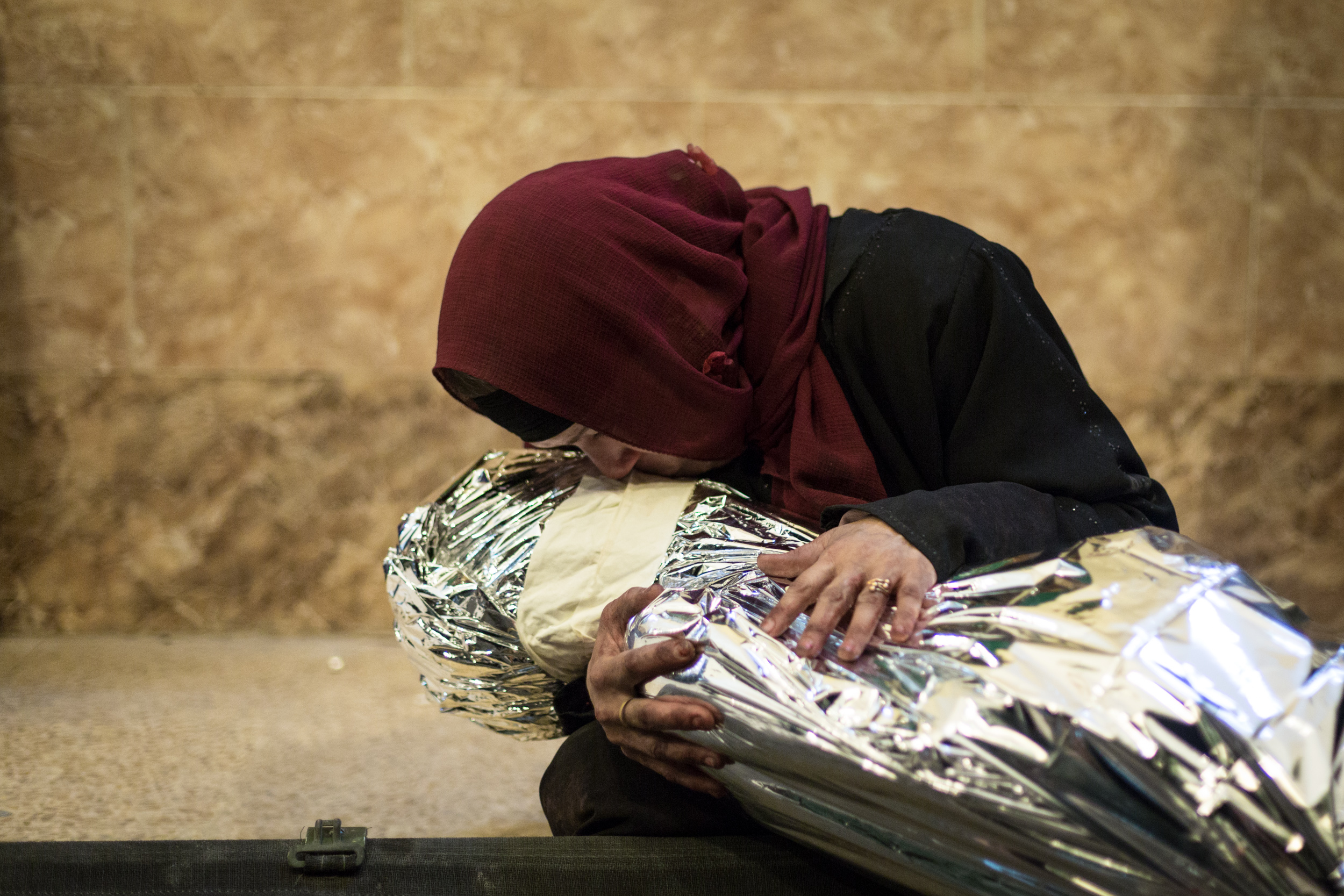
Ali’s mother, Noor, grieves over the body of her son. On the night of June 12, 2017 an airstrike hit Ali’s neighborhood in West Mosul, Iraq. The young Moslawi died from blunt force trauma and arrived at the Trauma Stabilization Point (TSP) “dead on arrival.” (Maranie R. Staab)
Interviews with more than 20 journalists and aid workers who were on the ground in Mosul, both during and immediately after the assault, strongly support the view that many thousands of civilians died. Their reporting also showed that simply speaking with locals—something the coalition and American authorities confirmed to us they almost never do as a matter of policy, and Iraqi federal authorities have also not done—can uncover the details of fatal incidents.
On January 24, Iraqi officials announced the liberation of East Mosul. In late February, Iraqi troops began the far tougher job of penetrating the dense Western part of the city, only capturing it five months later. In the climactic weeks of fighting in Mosul’s Old City, ISIS’s last stronghold in West Mosul, press footage showed civilians attempting harrowing escapes from blocks controlled by the group to those held by Iraqi forces. Many families didn’t make it out. Journalists and aid workers spoke of how Iraqi counter-terror forces—who they described as more careful to avoid endangering civilians—had been depleted in the early stages of the fight. As a result, the less-well-trained security forces took their place in the fight for Western Mosul.
Among them were the Iraqi Federal Police, notorious among locals for their negligence. According to several journalists and aid workers, by the end of the battle, Iraqi forces were launching crude explosive weapons into narrow areas packed with civilians. Some units launched improvised rockets from the back of vehicles. At the time, the Red Cross said civilians were fleeing, “bleeding even from their eyes.”
John Beck, a freelance journalist from Scotland, covered the assault. “When the West came, the Federal Police and Iraqi army took a more prominent role and were less discriminate in their use of heavy unguided artillery,” Beck said. “I began to hear more and more people who said they had relatives buried under the rubble. Many said entire families had been wiped out.”
Human-rights investigators took note. “The U.S.-led coalition was in joint enterprise with Iraqi forces. Its toleration for use of [rockets] enabled the killing of many, many civilians in Mosul,” Benjamin Walsby, a field researcher at Amnesty International, said. In July, Walsby and his colleagues released a significant report outlining the destruction in Mosul. Based on research that included interviews with more than 150 West Mosul residents, as well as medical workers, Amnesty accused ISIS of war crimes, but also said the coalition and Iraqi forces may have committed violations themselves. “I reject any notion that coalition fires were in any way imprecise, unlawful or excessively targeted civilians,” then-coalition commander Lieutenant General Stephen Townsend said in a press conference in July. “I would challenge the people from Amnesty International or anyone else out there who makes these charges to first research their facts.”

An elderly Iraqi man sits outside of a medical Trauma Stabilization Point (TSP) in West Mosul, Iraq. The man is the grandfather of Zainab, a young Moslawi that was injured and who ultimately died following an airstrike on the afternoon of May 31, 2017. (Maranie R. Staab)
Months later, an extensive investigation for The New York Times by journalists Azmat Khan and Anand Gopal determined that in certain areas of northern Iraq, total civilian deaths from coalition strikes during 2016 were more than 31 times higher than official estimates based on video taken by coalition planes and other sources of intelligence. The coalition, they reported, had often misidentified targets. Even with the benefit of drone surveillance and video feeds, its forces had killed civilians where ISIS was not present.
In December 2016, as Khan and Gopal were in the midst of their field research, the Obama administration extended the authority to call in airstrikes to personnel lower in the command chain, moving decision making further from headquarters and to the field level. (This practice continued and grew under the Trump administration, by Trump’s own account.) Khan and Gopal immediately noted an uptick in civilian deaths in areas they’d been surveying. “The number of cases we documented in East Mosul, just within 15 days, it was like night and day, so it was a real change on the ground,” Gopal said.
Journalists who embedded with Iraqi forces have offered specific examples of exactly how civilians were likely killed all over Mosul, and especially in the West, by both the coalition and Iraqi forces. Civilians faced excruciating choices, and often operated with limited knowledge of what was happening around them as they cowered in basements, unsure of how close Iraqi forces were. Who was in homes or other buildings targeted by airstrikes wasn’t always clear. “I can’t see into houses,” as one helicopter pilot told Stars and Stripes.
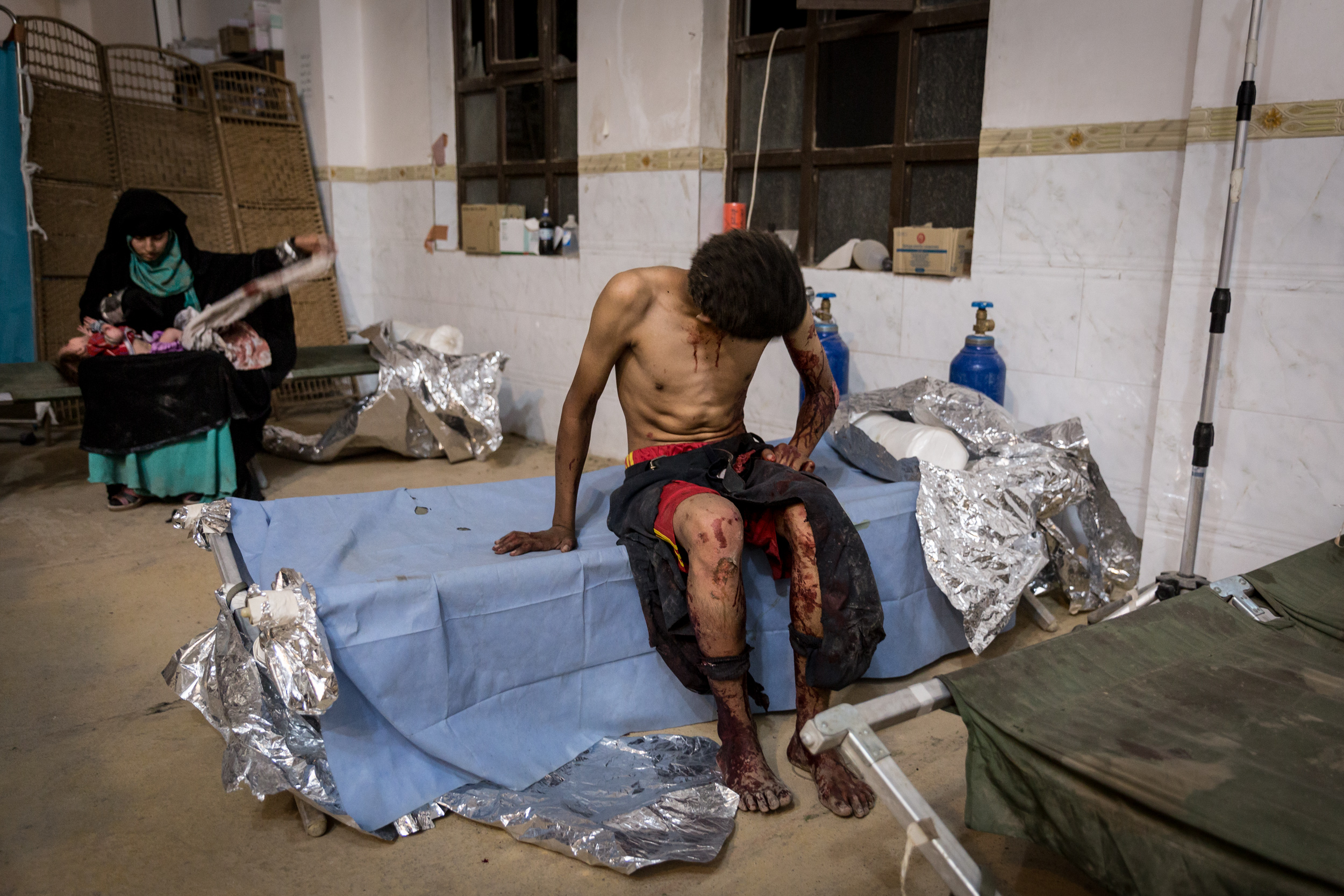
Injured civilians arrive at “Trauma Stabilization Point #2” in West Mosul, Iraq following an airstrike on the night of June 12, 2017. (Maranie R. Staab)
“We would hear stories of neighbors sheltering together, 40 people, 50 people in a basement,” one Western journalist who was based in Iraq during the assault, and asked that we not share their name due to ongoing work in the region told us. “You can imagine easily a whole family wiped out—a lot of families lived together so it would be parents, their kids and grandkids.”
ISIS certainly put civilians in extreme danger, fighting in their midst, using them as human shields, keeping them in booby-trapped buildings, or executing them outright. In a November report, the UN estimated that at least 741 civilians died in execution-style killings by ISIS during the battle for the city—and hundreds more in shelling and car bombings. Iraqi forces encountered a staggering 700 car bombs in Mosul, according to the coalition. Moslawis told Amnesty International how ISIS would bury bombs under the soil, so civilians were never sure where they could move. One witness recounted how ISIS fighters welded shut the front doors of houses. “They did this to our door, and even worse, they did it to another house in our neighborhood where hundreds of people were staying,” the witness said.
When civilians did flee, weapons fire could come from all sides. Naviseh Kohnavard, a Middle East correspondent for the BBC World Service, recalled the confusion in Zanjili, one of the neighborhoods in Western Mosul hit hardest by fighting. “I saw people coming out; they were bloody and most of the people were carrying out children, and many died in front of us,” she said. Investigations by Mike Giglio of BuzzFeed led the coalition to acknowledge responsibility for the deaths of 36 civilians—but only after he tracked down survivors and witnesses during reporting trips in May. “It’s such a chaotic situation and they don’t have people on the ground,” Giglio said. “All we did to get that information was we drove past checkpoints—my photographer and I—and then I went without an armed escort into civilian neighborhoods and I just asked people where there had been casualties.”
Giglio witnessed incidents first hand as well. In February, he embedded with Iraqi forces in Western Mosul when ISIS fighters—at least one using a tunnel to pop in and out of—began shooting anti-tank missiles in their direction. “I looked down the street and saw the ISIS guy who fired it—they called in an airstrike on this guy’s position,” Giglio said. “An airstrike hit the tunnel, the tunnel was in the street, and I saw it knock down one maybe two houses in the process,” Giglio said. “I think that’s how a lot of this stuff happens.”
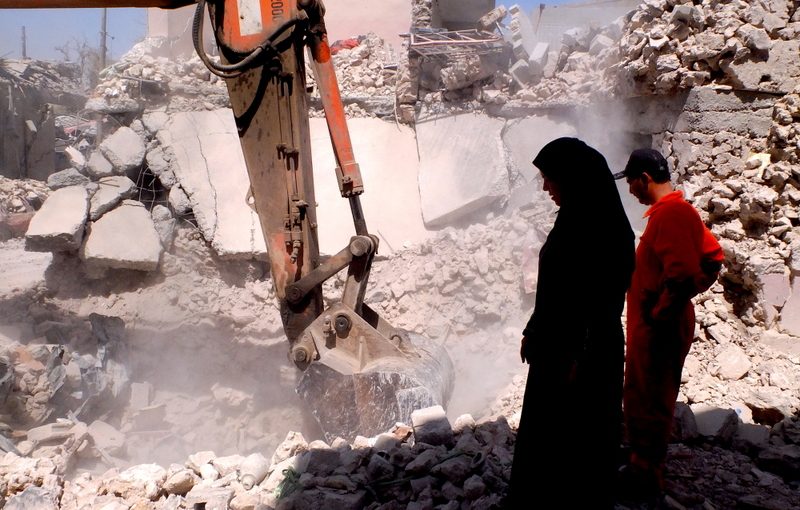
Nadia Aziz Mohammed looks on as Mosul civil defence officials search for the bodies of 11 family members, killed in a June 2017 airstrike (Photo by Sam Kimball. All rights reserved.)
Another incident occurred on June 20, in Western Mosul, uncovered later by American journalist Sam Kimball, who was reporting in the area. Once again, an ISIS fighter was seen on the roof of a family home. In the ensuing airstrike, Nadia Aziz Mohammed said she lost 11 relatives. A week later and filmed by Kimball, Mohammed stood a short distance from the home, watching as a bulldozer dug out the remains of her family. By this point in the conflict, the Coalition had informed Airwars that the Iraqi Air Force was no longer carrying out air raids on the city, meaning there was little doubt that any airstrike had been conducted by the U.S.-led alliance. (With the exception of its drones, ISIS had no air force.)
On another occasion—in East Mosul—Kimball told a young man he was looking to speak to victims of airstrikes. The man put out a call and locals began to come forward. “I spoke to so many people who either said I had relatives killed in an airstrike, or my neighbors were killed, or at least one of their family members were killed in an airstrike,” said the young American war reporter.
Among the 352 civilian deaths the coalition has admitted occurred during the Mosul assault, the United States has officially taken responsibility for only one incident that killed civilians to date. On March 17, 2017, an airstrike in the western neighborhood of al Jadida left over 100 civilians dead by the coalition’s own count—likely the deadliest strike during operations in the city. U.S. officials claimed that the two 500-pound bombs that targeted the roof of the building where civilians were sheltering then set off explosives held inside, though locals disagreed with this account.
Activists also moved into the information gap. Perhaps the best known of these is a social media account called “Mosul Eye” run by a Moslawi man named Omar Mohammed. Under ISIS rule and then during the battle for Mosul, “Mosul Eye” meticulously documented reports received from the city. The account relayed reports from sources inside Mosul, or family members of those trapped. These often would have been difficult to fully investigate during the assault. Mohammed maintained that many tens of thousands were killed during the fight for Mosul—an estimate that well exceeds the tallies arrived at by the AP and NPR. “Every day I was receiving reports of families killed by airstrikes or missiles—at least 20 or 25, sometimes 40 people were killed in one house and this was every day,” he told us.
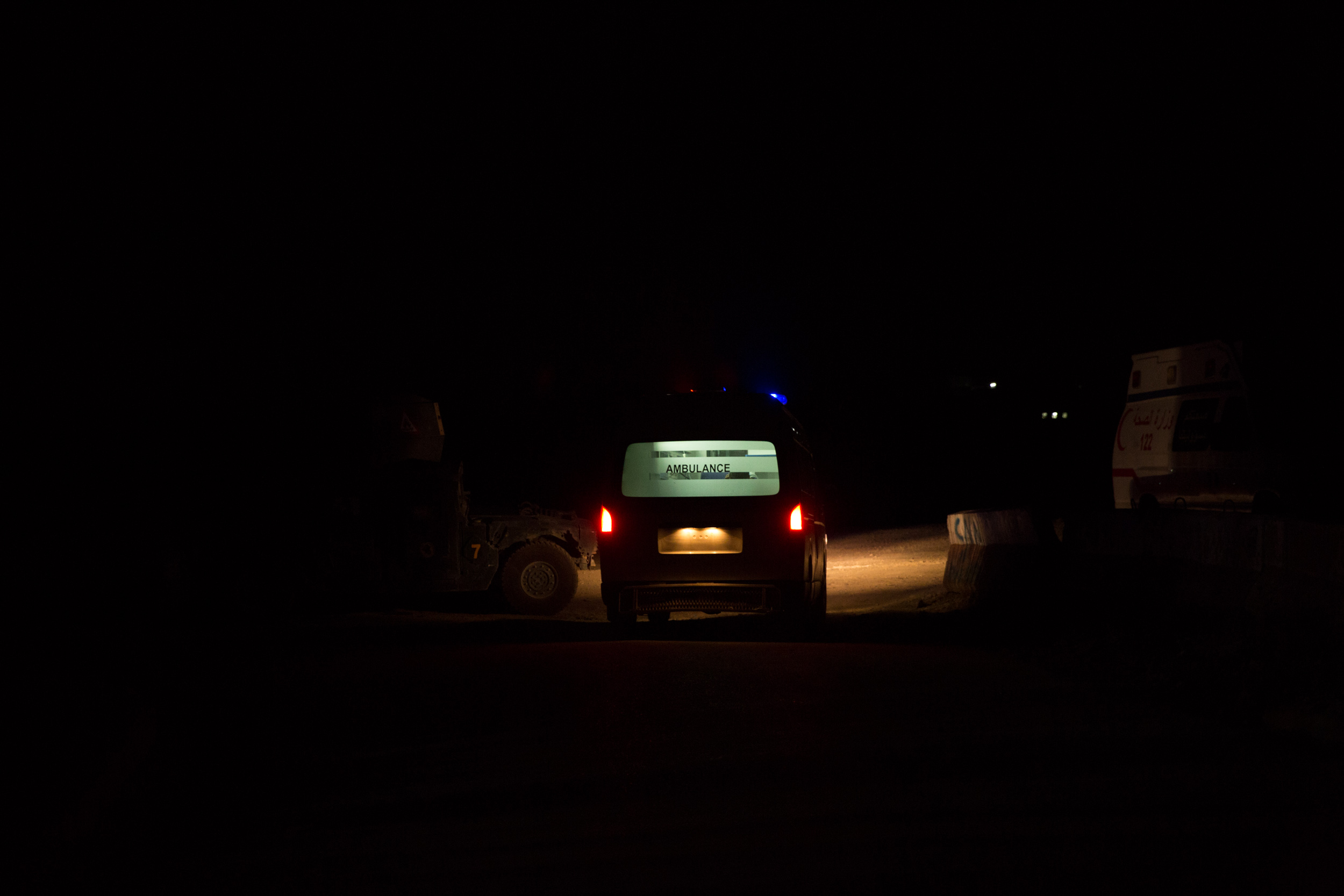
An ambulance leaves Trauma Stabilization Point #2 carrying injured civilians following an airstrike on the night of June 12, 2017. (Maranie R. Staab)
Though the coalition has made strides in reporting civilian harm, the gap between the deaths it has acknowledged and public estimates is substantial.
Across the entire coalition war against ISIS since 2014, the United States and its allies have so far conceded 841 civilian deaths—while Airwars places the likely minimum tally at 6,200 or more killed. As Khan and Gopal’s work has shown, that disparity may stem at least in part from serious procedural issues that implicate the military’s ability to track not just civilian deaths but the location of its bombs—and a failure to investigate events on the ground.
Moslawis recently marked a year since the al Jadida strike that killed over 100 people. For a brief period in 2017, global attention was paid to those civilians killed or injured in the assault on Mosul, and to the limits of “precision” warfare in cities. A year later, the U.S. government appears unwilling to study the civilian toll of massive urban battlefields such as those in Mosul. Americans continue to wage wars without a true understanding of the costs, while Iraqi civilians understand them all too well.
